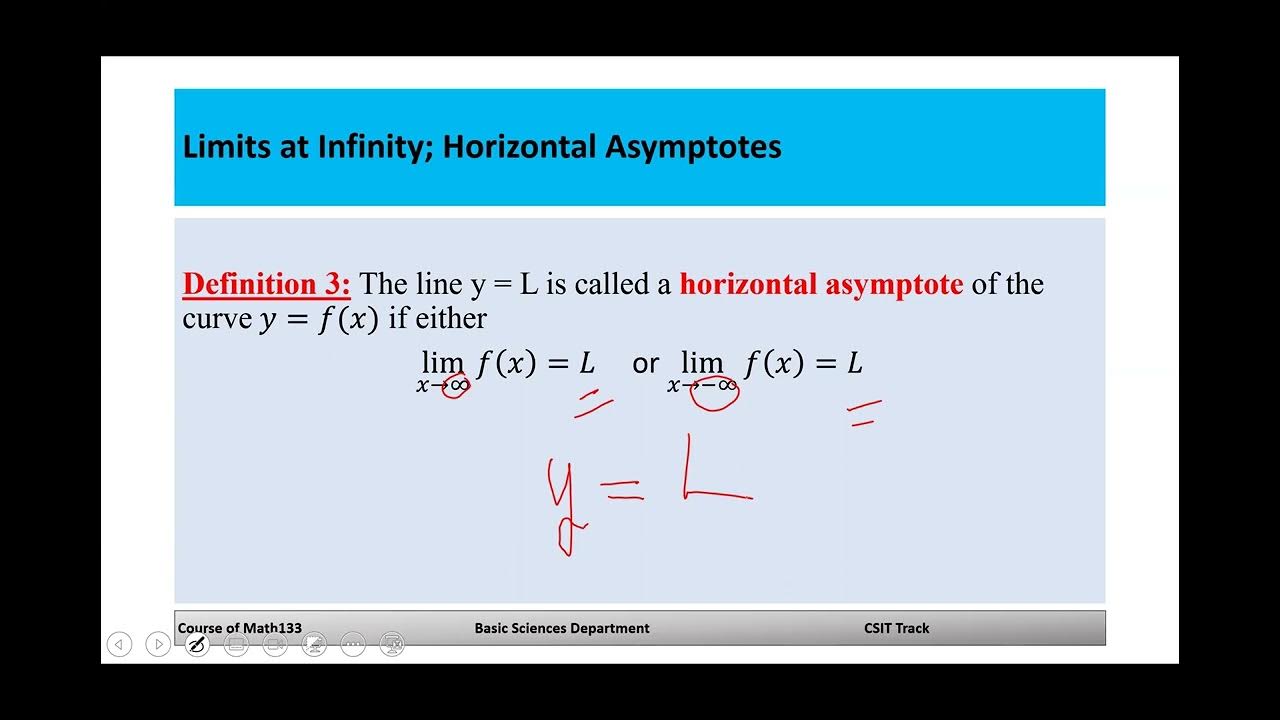Limits of Inverse Trigonometric Functions | Calculus
TLDRThis transcript delves into the concept of limits in calculus, specifically focusing on inverse trigonometric functions. It explains how the graph of the inverse tangent function has two horizontal asymptotes and demonstrates that the limit of the inverse tangent function approaches pi/2 as x approaches positive infinity and -pi/2 as x approaches negative infinity. The transcript further explores the limits of other inverse trigonometric functions, such as arc cosine and arc sine, and provides examples of how to evaluate them. It emphasizes the importance of understanding the graph's behavior and the concept of one-sided limits in solving these problems.
Takeaways
- 📈 Understanding the graph of the inverse tangent (arctan) is crucial for determining limits as x approaches infinity or negative infinity, with the function approaching π/2 and -π/2 respectively.
- 🚫 When evaluating limits of inverse trigonometric functions, direct substitution may not always be possible, and one-sided limits or alternative methods may be required.
- 🔢 For the function arctan(x) as x approaches 2 in the example given, the limit does not exist because the left-sided limit approaches negative infinity and the right-sided limit approaches positive infinity.
- 📊 The graph of 1/x has a vertical asymptote at x=0 and a horizontal asymptote of y=0, leading to the limit of arccos(1/x) as x approaches infinity being 0, or equivalently, arccos(0) which is π/2.
- 🥇 The domain and range of arc cosine (arccos) are from -1 to 1 and 0 to π, respectively, which helps in understanding the behavior of the function as x approaches its limits.
- 🧮 For the expression arcsin(5 + 2x^3 / (4x^3 - 8)), simplifying the limit as x approaches infinity involves multiplying the numerator and denominator by 1/x^3 and results in the arc sine of 1/2, which is π/6.
- 📐 The domain of arcsine (arcsin) is -1 to 1, and the range is -π/2 to π/2, which is important for determining the validity of the function's output.
- 🌐 When dealing with inverse trigonometric functions, it's beneficial to visualize the graphs and understand their asymptotic behavior for solving limit problems.
- 🔄 The process of finding limits often involves breaking down expressions and analyzing their behavior as they approach specific values or infinity.
- 📖 Memorizing the shapes of the graphs of inverse trigonometric functions can greatly simplify the process of evaluating limits in calculus problems.
Q & A
What is the limit of the inverse tangent function as x approaches infinity?
-The limit of the inverse tangent function as x approaches infinity is pi/2.
What are the two horizontal asymptotes for the graph of the inverse tangent function?
-The two horizontal asymptotes for the graph of the inverse tangent function are y = pi/2 and y = -pi/2.
How does the graph of the inverse tangent function behave as x approaches negative infinity?
-As x approaches negative infinity, the graph of the inverse tangent function approaches the horizontal asymptote y = -pi/2.
Why can't direct substitution be used to find the limit of arc tangent of (1/x - 2) as x approaches 2?
-Direct substitution cannot be used because it results in an undefined expression with a 0 in the denominator when x equals 2.
What do one-sided limits indicate in the context of the function arc tangent of (1/x - 2) as x approaches 2?
-One-sided limits indicate the behavior of the function as it approaches the given value from either the left or the right, which can differ in this case, leading to the conclusion that the original limit does not exist.
What is the limit of the expression 1/x as x approaches infinity in the context of the function arc cosine of (1/x)?
-The limit of the expression 1/x as x approaches infinity is 0, which corresponds to the arc cosine of 0, yielding a result of pi/2.
How does the graph of the function 1/x behave as x approaches infinity?
-As x approaches infinity, the graph of the function 1/x approaches a y-value of zero, following the horizontal asymptote y = 0.
What is the domain and range of the arc sine function?
-The domain of the arc sine function is from -1 to 1, and the range is from -pi/2 to pi/2.
What is the value of the arc sine of 1/2?
-The value of the arc sine of 1/2 is pi/6.
Why is it important to consider the domain and range when evaluating the arc sine of a given value?
-It is important to consider the domain and range because the arc sine function is only defined within those specific intervals, and values outside of these intervals do not have a corresponding arc sine value.
How can the limit of a rational function involving inverse trigonometric functions be evaluated as x approaches infinity?
-The limit can be evaluated by multiplying the numerator and denominator by 1/x^3 and then determining the limit of the resulting expression, considering that terms involving 1/x^3 will approach zero.
Outlines
📚 Understanding Limits of Inverse Trigonometric Functions
This paragraph introduces the concept of evaluating limits of inverse trigonometric functions, specifically focusing on the inverse tangent function. It explains the graphical representation of the arc tangent function, highlighting its two horizontal asymptotes at y = pi/2 and y = -pi/2. The discussion includes how the value of the function approaches pi/2 as x approaches positive infinity and -pi/2 as x approaches negative infinity. The paragraph emphasizes the importance of understanding the graph of a function when evaluating its limits and provides a method for finding the limit of the arc tangent function as x approaches a specific value, demonstrating the process with an example.
🔢 Analyzing Limits with One-Sided Approaches
This paragraph delves into the technique of evaluating limits using one-sided approaches, especially when direct substitution is not possible. The example given involves the limit of arc tangent of (x - 2)/(x - 2) as x approaches 2. The explanation shows how to break down the problem into left-sided and right-sided limits, highlighting the behavior of the function as it approaches the vertical asymptote at x = 2 from both directions. The paragraph also discusses the concept of vertical and horizontal asymptotes and how they can be used to determine the behavior of the function near the point of interest. The conclusion is that the original limit does not exist due to the discrepancy between the left and right-sided limits.
🌐 Evaluating Limits of Arc Cosine and Arc Sine Functions
This paragraph explores the limits of arc cosine and arc sine functions as x approaches infinity. It begins with the graph of 1/x and its behavior near the vertical asymptote at x = 0, explaining that the limit of this expression as x approaches infinity is zero, which corresponds to the arc cosine of zero, evaluated as pi/2. The paragraph then moves on to discuss the arc sine function, detailing its domain and range, and how to find the arc sine of specific values. An example is provided, calculating the limit of a more complex expression involving arc sine as x approaches positive infinity. The explanation includes a step-by-step breakdown of the process, leading to the conclusion that the limit is pi/6. The paragraph emphasizes the importance of understanding the domain and range of trigonometric functions when solving these types of problems.
Mindmap
Keywords
💡limit
💡inverse trigonometric functions
💡horizontal asymptotes
💡arctangent
💡one-sided limits
💡rational function
💡arc cosine
💡vertical asymptote
💡domain and range
💡arc sine
💡sine function
Highlights
The limit of the inverse tangent of x as x approaches infinity is pi/2.
The graph of the inverse tangent function has two horizontal asymptotes at y = pi/2 and y = -pi/2.
The limit of the inverse tangent of x as x approaches negative infinity is -pi/2.
Evaluating limits of inverse trigonometric functions is simplified by understanding their graphs.
The limit of arc tangent of (1/x - 2) as x approaches 2 does not exist due to differing left and right sided limits.
The limit of arc tangent from the left side as x approaches 2 is negative infinity.
The limit of arc tangent from the right side as x approaches 2 is positive infinity.
The graph of 1/x has a vertical asymptote at x=0 and a horizontal asymptote of y=0.
The limit as x approaches infinity for the expression 1/x is 0, which is equal to the arc cosine of zero.
Arc cosine of zero is pi/2, as cosine of pi/2 is 0.
The limit as x approaches infinity for the expression arcsin(5 + 2x^3)/(x^3 - 8) is pi/6.
The domain of arcsine is -1 to 1, and the range is -pi/2 to pi/2.
Sine of pi/6 is 1/2, thus the arc sine of 1/2 is pi/6.
When dealing with limits at infinity, rational functions can be manipulated by multiplying the numerator and denominator by 1/x^3.
The arc sine function only exists in quadrants III and IV of the unit circle.
Sine of 5pi/6 is 1/2, but arc sine of 1/2 does not equal 5pi/6 due to the limited range of arc sine.
This video provides a comprehensive guide on solving limits involving inverse trigonometric functions.
Transcripts
Browse More Related Video

Math 133 Lecture 2 6

Limits "at" infinity

AP Calculus AB - 1.15 Connecting Limits at Infinity and Horizontal Asymptotes

Introduction to infinite limits | Limits and continuity | AP Calculus AB | Khan Academy

Finding limits at infinity using squeeze theorem | Squeeze or Sandwich Theorem - Calculus

Limits at Infinity & Horizontal Asymptotes
5.0 / 5 (0 votes)
Thanks for rating: